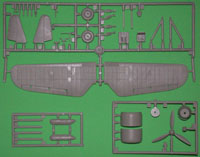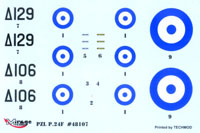Mirage 1/48 PZL P.24F
|
 |
Overview
For a detailed history on the PZL P.24, I highly recommend the new Kagero
book on the type. This kit is specifically for the Greek P.24F, which
featured twin 20mm Oerlikon cannon armament. During the war against Germany
and Italy in 1940 and 1941, Greek pilots flying the PZL P.24 downed forty
enemy aircraft, including one Italian bomber that was rammed by Lt. Marinos
Mitralexis.
The Kit
 The
Mirage PZL P.24 kits are little gems that will lend themselves well to
building. While the majority of the parts are injection plastic, the kit
comes with a handful of resin and etched brass as well, making for a nicely
detailed final model. The parts are molded in a light gray plastic, with
recessed panel lines and petite corrugation treatment on the wings and
tail. Since this is the P.24F, the decal sheet provides markings for a
couple of Greek aircraft. The
Mirage PZL P.24 kits are little gems that will lend themselves well to
building. While the majority of the parts are injection plastic, the kit
comes with a handful of resin and etched brass as well, making for a nicely
detailed final model. The parts are molded in a light gray plastic, with
recessed panel lines and petite corrugation treatment on the wings and
tail. Since this is the P.24F, the decal sheet provides markings for a
couple of Greek aircraft.
 Looking
at the interior, this is made up of photoetch and plastic and, coupled
with the molded-in sidewall detail, the finished cockpit will look quite
nice. The fuselage halves neatly trap the cockpit in place, and from that
point forward the construction is very straightforward. The engine is
decent, although little will be visible inside the tight cowling, especially
with the large cone on the front. The cowling itself is split into two
pieces, and the exhaust collectors are cast resin. Looking
at the interior, this is made up of photoetch and plastic and, coupled
with the molded-in sidewall detail, the finished cockpit will look quite
nice. The fuselage halves neatly trap the cockpit in place, and from that
point forward the construction is very straightforward. The engine is
decent, although little will be visible inside the tight cowling, especially
with the large cone on the front. The cowling itself is split into two
pieces, and the exhaust collectors are cast resin.
 The
innovative Pulawski wing comes molded as a solid upper piece with right
and left lower pieces. the cannon gondolas are molded separately, making
multiple versions easy. The arrangement of struts for the wings and landing
gear looks to be solid, with positive locators. This should result in
a strong assembly well capable of supporting the finished model. Other
details include separate side radiators, a choice of spatted or unspatted
wheels, and photoetch aileron actuators. The
innovative Pulawski wing comes molded as a solid upper piece with right
and left lower pieces. the cannon gondolas are molded separately, making
multiple versions easy. The arrangement of struts for the wings and landing
gear looks to be solid, with positive locators. This should result in
a strong assembly well capable of supporting the finished model. Other
details include separate side radiators, a choice of spatted or unspatted
wheels, and photoetch aileron actuators.
 The
decals are basic, as the Greek P.24Fs did not carry much in the way of
markings. Two options are included, both camouflaged birds. The first
is finished in green and light brown over light blue and the second is
green and dark brown over light blue. In addition to the Greek roundels,
the only other markings were fuselage serials, the first being D106 and
the second D129. The decals are printed by Techmod and are nicely done. The
decals are basic, as the Greek P.24Fs did not carry much in the way of
markings. Two options are included, both camouflaged birds. The first
is finished in green and light brown over light blue and the second is
green and dark brown over light blue. In addition to the Greek roundels,
the only other markings were fuselage serials, the first being D106 and
the second D129. The decals are printed by Techmod and are nicely done.
Conclusion
This is a wonderful model of one of the unsung aircraft of the Second
World War, one which played an important part in the history of the countries
that flew them. The basic construction coupled with high detail inside
the box should result in a pleasant build.
My thanks to Squadron for the review sample.
|
|
